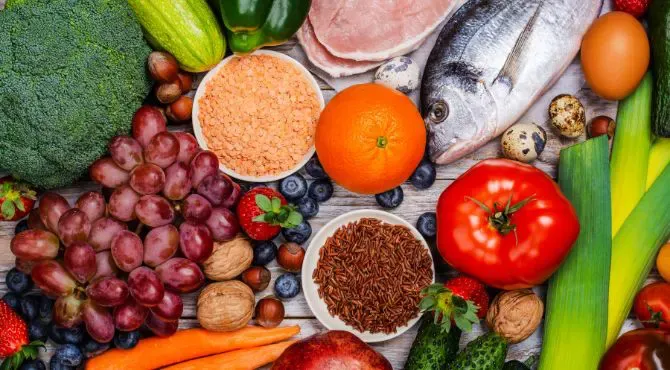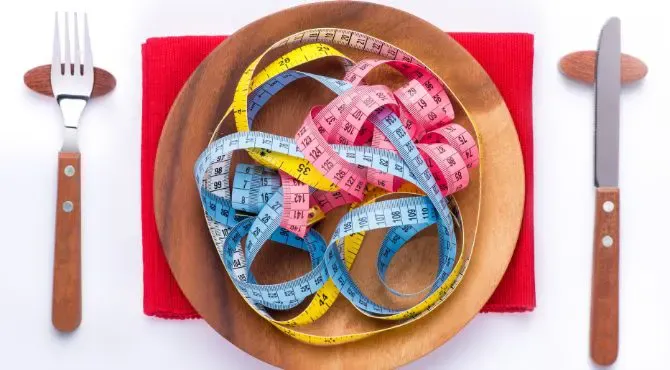Successful dietary rebalancing
Food rebalancing consists of correcting bad habits and eating better
daily. Our advice and the best foods to achieve this.

In general, food rebalancing consists of eating better, healthier, and balanced daily. This approach has a double utility.
On the one hand, it allows you to correct your bad habits: snacking, insufficient hydration, and too fatty or sweet meals.
It also highlights errors such as chewing too quickly.
On the other hand, it encourages people to adopt better habits and favor certain foods to develop healthy and balanced meals.
It is based in particular on 5 major groups of foods and nutrients:
On the other hand, food rebalancing consists more of a global review of your diet.
All foods are permitted, provided they are consumed without excess. Therefore,
its ultimate goal is not weight loss, although it can contribute to it.
In the short term, its benefits are numerous:

Kale, spinach, chard, broccoli, or beans are great. Kale, for example, is low in calories and an excellent source of vitamin C.
You can make them steamed, pureed, salads, juices, or green smoothies.
Choose apples, pears, oranges, strawberries, or even bananas. Also, bet on dried fruits: apricots, figs, dates.
You can eat them fresh, in mixed salads, or add them to a smoothie.
In addition, it has beneficial effects on intestinal transit.
Consume it in the form of flakes, bran, or oat milk. To make porridge, swell oatmeal in hot milk for 15 minutes.
Excellent for filling small appetites, they provide energy.
Almonds, walnuts, Brazil nuts, chia, and hemp seeds. Are must-haves!
It must contain at least 70% cocoa and cocoa butter. Below it is too sweet and nutritionally uninteresting.
You can also opt for raw chocolate made from unroasted beans, which are richer in nutrients.
Cocoa is rich in vitamins, amino acids, minerals, and antioxidants. It also contains theobromine, a stimulating and energizing molecule.
Of course, consume chocolate in moderation and occasionally.

Thus, we distinguish the foods to favor, those to consume in small quantities, and those to eat occasionally.
Here is a summary table for composing healthy plates that provide the body with the necessary nutrients.
Food rebalancing will encourage you to cook yourself at home. So you'll know exactly what's on your plate.
You will also enjoy preparing natural products: seasonal fruits and vegetables, fresh meat, and fish.
If possible, buy organic products to avoid as many pesticides as possible.
You can cook daily or prepare your meals for the week in advance using the "batch cooking" method.
Allow yourself deviations during the week without feeling guilty. You must not be in a private or too restrictive approach.
This contributes to the better digestion of proteins and makes it possible to feel the feeling of satiety better.
Also, reconnect with your body and listen to it. Thus, it would help if you distinguished between the desire to eat (greediness) and hunger.
Finally, stop eating when you feel full and not finish your plate. In this case, it may be wise to eat from smaller plates to avoid overeating.
To avoid them, eat regularly and don't skip meals like breakfast. By eating in the morning, you can last until noon without feeling hungry.
And if you feel like snacking, go for a fruit, a homemade cereal bar, a yogurt, or a square of raw or dark chocolate at 70% minimum.
Plus, water is a natural appetite suppressant. Thus, drinking a glass of water can be enough to satisfy a craving for a snack.
You can drink water or indulge yourself with tea or herbal tea. Always have a water bottle with you when traveling.
It takes several months or even several years to establish and maintain a balanced lifestyle over the long term.
The changes happen gradually. Don't give up, don't feel guilty at the slightest deviation, and be persistent!
What is food rebalancing?

In general, food rebalancing consists of eating better, healthier, and balanced daily. This approach has a double utility.
On the one hand, it allows you to correct your bad habits: snacking, insufficient hydration, and too fatty or sweet meals.
It also highlights errors such as chewing too quickly.
On the other hand, it encourages people to adopt better habits and favor certain foods to develop healthy and balanced meals.
It is based in particular on 5 major groups of foods and nutrients:
- fruits and vegetables
- proteins
- dairy products
- carbohydrates
- lipids
On the other hand, food rebalancing consists more of a global review of your diet.
It does not involve a calorie deficit and does not cause frustrations.
In the short term, its benefits are numerous:
- weightloss
- increase in energy
- better digestion
- mood improvement
- reduced risk of cardiovascular disease or hypertension
The best foods for nutritional rebalancing

The green vegetables
Green vegetables provide reasonable amounts of vitamins, minerals, and antioxidants. In addition, they are low in fat but high in water.Kale, spinach, chard, broccoli, or beans are great. Kale, for example, is low in calories and an excellent source of vitamin C.
You can make them steamed, pureed, salads, juices, or green smoothies.
The fruits
Fruits contain vitamins, fiber, and water. In addition to being nutritious, they are filling and perfect as a snack.Choose apples, pears, oranges, strawberries, or even bananas. Also, bet on dried fruits: apricots, figs, dates.
You can eat them fresh, in mixed salads, or add them to a smoothie.
Oats
Oats are a perfect cereal to accompany a food rebalancing. Rich in soluble fibers and vegetable proteins, it is satiating and promotes the feeling of satiety.In addition, it has beneficial effects on intestinal transit.
Consume it in the form of flakes, bran, or oat milk. To make porridge, swell oatmeal in hot milk for 15 minutes.
Seeds and oilseeds
Seeds and oilseeds are a source of minerals, trace elements, vitamins, proteins, and good fatty acids.Excellent for filling small appetites, they provide energy.
Almonds, walnuts, Brazil nuts, chia, and hemp seeds. Are must-haves!
Dark chocolate
Who said we had to deprive ourselves of chocolate? You can eat it as long as it is black.It must contain at least 70% cocoa and cocoa butter. Below it is too sweet and nutritionally uninteresting.
You can also opt for raw chocolate made from unroasted beans, which are richer in nutrients.
Cocoa is rich in vitamins, amino acids, minerals, and antioxidants. It also contains theobromine, a stimulating and energizing molecule.
Of course, consume chocolate in moderation and occasionally.
How to succeed in your food rebalancing?

Prioritize certain foods
If you can eat everything, certain foods are still preferred as part of a rebalancing.Thus, we distinguish the foods to favor, those to consume in small quantities, and those to eat occasionally.
Here is a summary table for composing healthy plates that provide the body with the necessary nutrients.
| Foods to favor | Foods to consume in small quantities | Foods to eat occasionally |
|---|---|---|
|
Fruits and vegetables Whole grains Legumes Seeds and oilseeds Eggs Lean fish (pike, cod, yellowfin tuna, etc.) Lean meats (chicken, turkey, rabbit, etc.) |
Dairy products Fatty fish (salmon, herring, mackerel, etc.) White cereals | Biscuits and pastries Fried foods Fatty meats (lamb, beef, pork, etc.) Charcuterie Alcoholic beverages Sweetened beverages |
Reduce processed products
Avoid processed foods and ready meals as much as possible. They often contain additives, are very salty-sweet, and contain harmful fats.Food rebalancing will encourage you to cook yourself at home. So you'll know exactly what's on your plate.
You will also enjoy preparing natural products: seasonal fruits and vegetables, fresh meat, and fish.
If possible, buy organic products to avoid as many pesticides as possible.
You can cook daily or prepare your meals for the week in advance using the "batch cooking" method.
Know how to have fun
Learning to have fun is the key to effective and lasting food rebalancing. Avoid frustrations and do not hesitate to vary the menus to enjoy eating.Allow yourself deviations during the week without feeling guilty. You must not be in a private or too restrictive approach.
Learn to eat well again
Ideally, the duration of a meal should be between 20 and 30 minutes. It is important to eat slowly, chew well, and chew food.This contributes to the better digestion of proteins and makes it possible to feel the feeling of satiety better.
Also, reconnect with your body and listen to it. Thus, it would help if you distinguished between the desire to eat (greediness) and hunger.
Finally, stop eating when you feel full and not finish your plate. In this case, it may be wise to eat from smaller plates to avoid overeating.
Avoid snacking and eat at set times.
Snacking should be kept to a minimum. They increase daily caloric intake and body fat.To avoid them, eat regularly and don't skip meals like breakfast. By eating in the morning, you can last until noon without feeling hungry.
And if you feel like snacking, go for a fruit, a homemade cereal bar, a yogurt, or a square of raw or dark chocolate at 70% minimum.
To drink a lot of water.
Hydration is essential for vital functions and for eliminating waste from the body. It is advisable to drink 1.5 L per day.Plus, water is a natural appetite suppressant. Thus, drinking a glass of water can be enough to satisfy a craving for a snack.
You can drink water or indulge yourself with tea or herbal tea. Always have a water bottle with you when traveling.
To be patient
Food rebalancing requires patience. Indeed, relearning to eat and changing habits takes time.It takes several months or even several years to establish and maintain a balanced lifestyle over the long term.
The changes happen gradually. Don't give up, don't feel guilty at the slightest deviation, and be persistent!
Read More:
Post a Comment